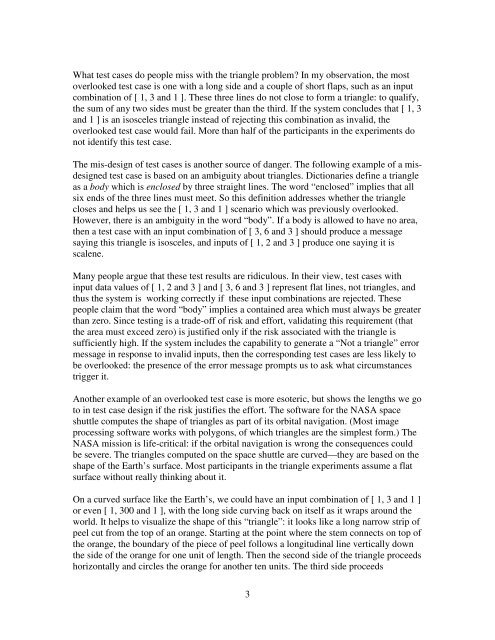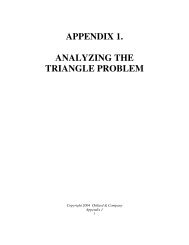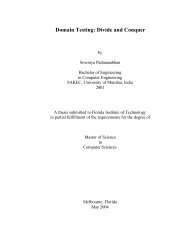Exercise: Analyzing the Triangle Problem - Testing Education
Exercise: Analyzing the Triangle Problem - Testing Education
Exercise: Analyzing the Triangle Problem - Testing Education
You also want an ePaper? Increase the reach of your titles
YUMPU automatically turns print PDFs into web optimized ePapers that Google loves.
What test cases do people miss with <strong>the</strong> triangle problem? In my observation, <strong>the</strong> most<br />
overlooked test case is one with a long side and a couple of short flaps, such as an input<br />
combination of [ 1, 3 and 1 ]. These three lines do not close to form a triangle: to qualify,<br />
<strong>the</strong> sum of any two sides must be greater than <strong>the</strong> third. If <strong>the</strong> system concludes that [ 1, 3<br />
and 1 ] is an isosceles triangle instead of rejecting this combination as invalid, <strong>the</strong><br />
overlooked test case would fail. More than half of <strong>the</strong> participants in <strong>the</strong> experiments do<br />
not identify this test case.<br />
The mis-design of test cases is ano<strong>the</strong>r source of danger. The following example of a misdesigned<br />
test case is based on an ambiguity about triangles. Dictionaries define a triangle<br />
as a body which is enclosed by three straight lines. The word “enclosed” implies that all<br />
six ends of <strong>the</strong> three lines must meet. So this definition addresses whe<strong>the</strong>r <strong>the</strong> triangle<br />
closes and helps us see <strong>the</strong> [ 1, 3 and 1 ] scenario which was previously overlooked.<br />
However, <strong>the</strong>re is an ambiguity in <strong>the</strong> word “body”. If a body is allowed to have no area,<br />
<strong>the</strong>n a test case with an input combination of [ 3, 6 and 3 ] should produce a message<br />
saying this triangle is isosceles, and inputs of [ 1, 2 and 3 ] produce one saying it is<br />
scalene.<br />
Many people argue that <strong>the</strong>se test results are ridiculous. In <strong>the</strong>ir view, test cases with<br />
input data values of [ 1, 2 and 3 ] and [ 3, 6 and 3 ] represent flat lines, not triangles, and<br />
thus <strong>the</strong> system is working correctly if <strong>the</strong>se input combinations are rejected. These<br />
people claim that <strong>the</strong> word “body” implies a contained area which must always be greater<br />
than zero. Since testing is a trade-off of risk and effort, validating this requirement (that<br />
<strong>the</strong> area must exceed zero) is justified only if <strong>the</strong> risk associated with <strong>the</strong> triangle is<br />
sufficiently high. If <strong>the</strong> system includes <strong>the</strong> capability to generate a “Not a triangle” error<br />
message in response to invalid inputs, <strong>the</strong>n <strong>the</strong> corresponding test cases are less likely to<br />
be overlooked: <strong>the</strong> presence of <strong>the</strong> error message prompts us to ask what circumstances<br />
trigger it.<br />
Ano<strong>the</strong>r example of an overlooked test case is more esoteric, but shows <strong>the</strong> lengths we go<br />
to in test case design if <strong>the</strong> risk justifies <strong>the</strong> effort. The software for <strong>the</strong> NASA space<br />
shuttle computes <strong>the</strong> shape of triangles as part of its orbital navigation. (Most image<br />
processing software works with polygons, of which triangles are <strong>the</strong> simplest form.) The<br />
NASA mission is life-critical: if <strong>the</strong> orbital navigation is wrong <strong>the</strong> consequences could<br />
be severe. The triangles computed on <strong>the</strong> space shuttle are curved—<strong>the</strong>y are based on <strong>the</strong><br />
shape of <strong>the</strong> Earth’s surface. Most participants in <strong>the</strong> triangle experiments assume a flat<br />
surface without really thinking about it.<br />
On a curved surface like <strong>the</strong> Earth’s, we could have an input combination of [ 1, 3 and 1 ]<br />
or even [ 1, 300 and 1 ], with <strong>the</strong> long side curving back on itself as it wraps around <strong>the</strong><br />
world. It helps to visualize <strong>the</strong> shape of this “triangle”: it looks like a long narrow strip of<br />
peel cut from <strong>the</strong> top of an orange. Starting at <strong>the</strong> point where <strong>the</strong> stem connects on top of<br />
<strong>the</strong> orange, <strong>the</strong> boundary of <strong>the</strong> piece of peel follows a longitudinal line vertically down<br />
<strong>the</strong> side of <strong>the</strong> orange for one unit of length. Then <strong>the</strong> second side of <strong>the</strong> triangle proceeds<br />
horizontally and circles <strong>the</strong> orange for ano<strong>the</strong>r ten units. The third side proceeds<br />
3








